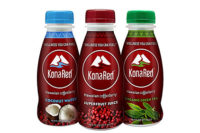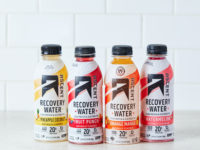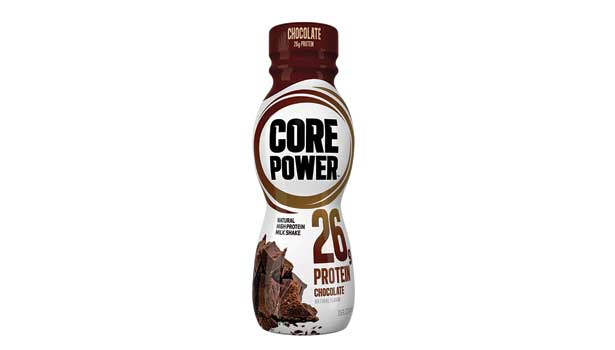Whey protein capitalizes on health benefits
Consumer awareness helps ingredient find its niche

Fair Oaks Farms Brands’ Core Power brand is made up of 20 percent whey protein and 80 percent casein.

Containing a complex protein matrix, New Whey Nutrition’s Fit2Go Nutrition Drinks feature a proprietary blend of collagen protein isolate, whey protein isolate and casein protein isolate.

Adding to its lineup, WheyUP, a brand of Shadow Beverages and Snacks, released Berry, Grape and Orange varieties. Each contains 20 grams of whey protein.



With its associations to lean muscle mass and satiety claims, whey protein continues to be an ingredient of interest to beverage manufacturers. According to Mintel’s Global New Products Database, from March 2012 to August 2012, 19 new beverages were released that contain whey protein. Product releases featured a number of formats including powders, smoothies, ready-to-drink (RTD) offerings and shots, based on the Chicago-based market research firm’s data.
Reaffirming the links to whey protein and lean muscles, the Dairy Research Institute funded a study that was presented at the American College of Sports Medicine (ACSM) Annual Meeting by the study’s principal investigator, Jeff Volek, associate professor at the University of Connecticut. The study followed participants for nine months as they completed a resistance training program three times a week. Participants were given either 20 grams of whey protein concentrate or soy isolate daily at breakfast on non-training days or immediately following exercise, it states.
“After completing nine months of resistance training, all participants experienced increases in lean muscle mass,” Volek said in a statement. “The gains for participants consuming whey protein
(3.3 kg) were significantly greater than for participants consuming soy protein (1.8 kg) — potentially due to the branched-chain amino acid content of the whey protein.”
‘Whey’ more information
As more research becomes available, consumers are gaining the knowledge about whey protein and how to apply it to their lifestyles.
“Consumer awareness of the benefits of whey protein has increased, and whey-enriched products have expanded beyond the shelves of specialist sports nutrition outlets,” says Shanna Smidt, business development manager with Glanbia Nutritionals, a subsidiary of Glanbia plc, Kilkenny, Ireland. “Over 54 percent of consumers are trying to increase the amount of protein in their diet compared to a year ago, and 47 percent indicate that the message ‘good source of protein’ is important on labels.”
Smidt adds that studies have found protein to have a positive effect on muscle protein synthesis, sarcopenia (loss of muscle mass), cardiovascular health, bone health, immunity and general well-being.
“Whey protein contains higher concentrations of branched-chain amino acids (BCAA) and essential amino acids than other sources of protein, making it an ideal option for a dietary supplement,” she says. “Whey proteins in beverages provide a convenient method of protein delivery to help prevent sarcopenia.”
In addition to the nutritional benefits of whey protein, numerous trends are impacting its growth in the food and beverage marketplace.
“One of the biggest factors in the growth of natural protein ingredients is the expansion of the market,” Smidt says. “The popularity of protein-enhanced beverages now reaches beyond elite athletes and professional body builders to mainstream athletes and everyday gym-goers.”
Smidt adds that the clean label trend also is affecting the inclusion of protein in beverages.
“Consumers want to recognize the ingredients that they consume,” she says. “A shorter ingredient list is desirable, but this should not reduce the quality of the beverage’s taste, texture and flavor. Protein systems are being developed that can replace ingredients that are less desirable and provide a cleaner label with a shorter ingredient declaration.”
As research continues to support the benefits of whey protein supplementation, The U.S. Dairy Export Council notes that whey protein cannot be manufactured by the body but can be obtained through nutritional offerings. Because of this, it presents beverage-makers an opportunity to fill this niche.
“Beverages are a very convenient mode of nutrition delivery, especially in a ready-to-drink form,” says Grace Harris, director of applications for Hilmar Ingredients, Hilmar, Calif. “There are more and more companies wanting to develop a beverage with better nutrition, and most want to include protein. Whey is not just for the sports market as a recovery beverage anymore as average consumers find that a meal replacement beverage is more satisfying and easier to consume than bars or a regular multi-course meal.
“There are more concepts for protein in waters, ‘clear beverages,’ teas and coffees, and juices,” she continues. “These types of beverages can satisfy the craving of all demographics from children to the healthy aging population.”
Harris notes that depending on the type of protein and functional capacity, protein ingredients can be found within most beverage categories.
“Protein is used in meal replacement, recovery, sports nutrition and common daily beverages such as teas and coffees,” she says.
Consumer lifestyles also are impacting the growth of protein-enriched beverages.
“Busy modern lifestyles and long working hours mean consumers demand convenient ways of incorporating higher doses of protein into their diets,” Glanbia’s Smidt says. “Beverages provide an easy way to consume high-quality protein.”
Working with whey
Part of the allure to formulating with whey protein can be its neutral flavor, experts say.
“Whey protein can have a very clean, bland flavor, so less masking is required,” says Jeff Banes, applied technology manager with Grande Custom Ingredients, Lomira, Wis. “You can also get excellent clarity at low pH.”
When deciding which form of whey protein to work with, beverage-makers have a few options to consider. Glanbia’s Smidt says for whey protein, there are three types: concentrate, isolate and hydrolysate.
“Whey protein isolate (WPI) contains a higher degree of protein compared [with] whey protein concentrate (WPC),” she says. “WPI’s low lactose content increases appeal for the growing problem of lactose intolerance; plus, it offers a much lower fat content in comparison to WPC, [and] it is appealing to certain market segments, such as those seeking to lose weight.”
Smidt adds that WPI can be used in a wide range of products, including nutritional supplements and beverages. Additionally, whey protein hydrolysate (WPH) offers a similar fat and lactose content to WPI but can be digested more easily due to its easy-to-absorb peptides, and, as a result, the benefits can be felt more quickly, she says.
In contrast, Smidt notes that WPC typically comprises about 80 percent protein, which makes it ideal for use in nutritional and sports beverages. It also can be used for inclusion of high-quality whey protein and can be more cost effective than WPI, she adds.
Because of the number of app-lications of whey protein, Glanbia offers a range of proteins to meet the needs in the beverage space. Its new BevWise A-101 WS is designed for fortification of acidic pH beverages such as juices, Smidt says. It also can provide an optimal system of WPI and soy protein isolate for flavor and clarity, she adds.
For products such as smoothies or other beverages with an intermediate pH, Glanbia’s new BevWise I-300 series incorporates whey, milk and/or soy proteins, depending on what functional and nutritional benefits manufacturers are seeking, Smidt says.
Also recognizing the benefits of whey protein isolates, Hilmar has seen most interest in that realm as of late.
“At greater than 90 percent protein, they can deliver a higher protein boost without extra volume,” says Gwen Bargetzi, director of marketing for Hilmar.
Bargetzi notes that Hilmar 9000 WPI offers a neutral flavor and favorable mineral profile, which makes it suitable for practical fortification in RTD products. Additionally, its Hilmar 9420 WPI is designed for acidic beverages such as sport drinks and juices. Hilmar 9420 can help to reduce overall astringency and can deliver as much as 17 grams of protein in a 250-ml serving and still remain clear and refreshing, Bargetzi says. For dry mixes, the company offers Hilmar 9010 and 9410, which are both instantized WPIs with spoon-stirring dispersibility, she adds.
Offering a wide variety of options for beverage-makers to choose from can be important due to the different formulation options.
Grande Custom Ingredients offers its Grande Ultra line of WPIs. “These come in neutral pH as well as acidified versions so our customers can determine what works best for their beverage,” says Steve Dott, director of sales and marketing with Grande Custom Ingredients. “They also offer the highest degree of clarity for protein waters and fruit-flavored drinks. We also have a line of Grade A Yogurt Powders that provide excellent flavor and texture in high-protein smoothies.”
Although WPIs remain popular options for beverage developers, WPCs also can be an important ingredient for beverage fortification.
Atlanta-based CP Kelco offers Simplesse Microparticulated Whey Protein Concentrate, a dairy ingredient made from WPC. The WPC undergoes a unique process, resulting in uniform protein particles with an average diameter of one micron, the company says. The microparticulation process denatures the protein to impart a decreased tendency to aggregate and gel upon heating, it adds.
Simplesse contains 53 percent protein and can be labeled as whey protein on beverages, the company adds. BI
|
Protein options abound |
|
As beverage-makers look to offer consumers protein-fortified options, the opportunities for protein enrichment aren’t limited to whey. “Different protein systems, such as whey and soy, aren’t necessarily mutually exclusive anymore,” says Shanna Smidt, business development manager with Glanbia Nutritionals, a subsidiary of Glanbia plc, Kilkenny, Ireland. “[An] increasing number of manufacturers are including vegetable and grain-based proteins with whey or milk protein to provide beverages with a good source or excellent source of protein.” Smidt notes that one of the most widely used proteins for neutral pH beverages is milk protein. “In neutral pH nutrition drinks, we recommend a heat-stable product such as a milk protein-based ingredient,” she says. She adds that Glanbia Nutrasol ingredients are designed to provide a high-quality source of dairy proteins. Combinations of whey and soy also are gaining in popularity, Smidt says, but also highlight the importance of considering all factors during formulation. “When specifying protein sources, beverage developers should consider the end consumer market, how the protein will interact with other ingredients and the type of processing used to make the beverage,” she says. Hilmar, Calif.-based Hilmar Ingredients’ Grace Harris, director of application, notes that although whey proteins are the most versatile, beverages can benefit from numerous sources of protein. BI |
Looking for a reprint of this article?
From high-res PDFs to custom plaques, order your copy today!












